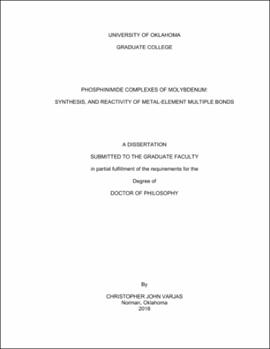| dc.contributor.advisor | Thomson, Robert | |
| dc.contributor.author | Varjas, Christopher | |
| dc.date.accessioned | 2018-07-26T15:46:29Z | |
| dc.date.available | 2018-07-26T15:46:29Z | |
| dc.date.issued | 2018 | |
| dc.identifier.uri | https://hdl.handle.net/11244/301308 | |
| dc.description.abstract | Methods were developed to synthesize new high-oxidation state molybdenum complexes supported by phosphinimide ligands ([R3P=N]-) that incorporate ligands with metal-element multiple bonds. A series of imido, oxido, and chlorido complexes were synthesized and characterized, with phosphinimide ligand installation through σ-bond metathesis, salt metathesis, and protonolysis proligand reactivity. Molybdenum(VI) oxido-dichlorido and imido-dichlorido complexes were synthesized through selective hexamethyldisiloxane elimination. Synthesis of cationic phosphinimide complexes was achieved through ion exchange with non-coordinating sodium tetrakis[3,5-bis(trifluoromethyl)phenyl]borate.
An efficient synthetic route to access the first neutral oxido-alkylidene molybdenum complex [(tBu3P=N)2Mo(O)(=CHSi(CH3)3] (3.1) was defined by alkylation of the oxido-dichlorido complex [(tBu3P=N)2Mo(O)Cl2] (2.4). Alkylidene complex 3.1 was shown to have lower activity than commercial catalysts towards catalytic ring-opening metathesis polymerization (ROMP) of norbornene.
Isolation and characterization of the tris(pentafluorophenyl)borane adduct [(tBu3P=N)2Mo(O-B(C6F5)3)(=CHSi(CH3)3] (3.3) of the oxido-alkylidene complex showed improved catalytic ROMP performance due to Lewis acid activation of the oxido ligand.
Comparison of the X-ray crystallographic structures of both oxido-alkylidene complexes revealed a molybdenum-oxygen bond length increase of 0.143(6) Å after borane coordination.
An efficient synthetic route was developed to isolate the first phosphinimide complex that contains an alkylidyne ligand (4.6), with a novel structure relative to known group VI alkylidyne species. Lewis acid activation of the alkylidyne complex, and preliminary reactivity studies with alkyne and nitrile substrates, indicate potential use as a metathesis catalyst.
Heteroallene cycloaddition with oxido ligands was evaluated as a general synthetic approach to access more valuable ligands. Aryl isocyanates (ArN=C=O) were shown to generate imido ligands through CO2 elimination. Diphenyl ketene was observed to undergo [1,2] addition with an oxido ligand to generate a rare ene-diolate ligand. A new synthetic route to generate phosphaketenes (RP=C=O) was explored, which utilized less toxic reagents than known methods.
From this work, synthetic methods were developed to access molybdenum(VI) phosphinimide complexes that incoporate a diverse range of ligands with metal-element multiple bonds. | en_US |
| dc.language | en_US | en_US |
| dc.subject | Chemistry, Inorganic. | en_US |
| dc.subject | Molybdenum Organometallic Complexes | en_US |
| dc.subject | Homogeneous Metathesis Catalysts | en_US |
| dc.title | Phosphinimide Complexes of Molybdenum: Synthesis, and Reactivity of Metal-Element Multiple Bonds | en_US |
| dc.contributor.committeeMember | Ashby, Michael | |
| dc.contributor.committeeMember | Richter-Addo, George | |
| dc.contributor.committeeMember | Sellers, Ian | |
| dc.contributor.committeeMember | Yip, Wai Tak | |
| dc.date.manuscript | 2018 | |
| dc.thesis.degree | Ph.D. | en_US |
| ou.group | College of Arts and Sciences::Department of Chemistry and Biochemistry | en_US |
| shareok.nativefileaccess | restricted | en_US |
